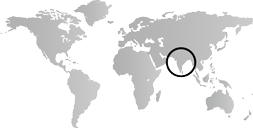At the start of this period, the Mughal dynasty is at the height of its power, having been secured and consolidated by Akbar (r. 1556-1605). Under his successors in the seventeenth century, more of the subcontinent is incorporated into the Mughal empire as the rulers of the Deccan are finally conquered and become Delhi’s feudatories. Rajput princes continue to be enlisted as generals in the imperial army, aiding the spread of Mughal ideas on art and architecture to the peripheral courts and also in the absorption of Rajput and other traditions into the Mughal world. After the death of the emperor Aurangzeb in 1707, the Mughal court declines in power and glory, and many of its feudatory states have an artistic florescence. Southern India remains independent of the Mughals. After the fall of the Vijayanagar dynasty in 1565, their former governors—the Nayakas, the Wodeyars, the Gowdas, and the Rayas—establish their own dynasties in the provinces they administered. They clash with the Deccani sultanates of Bijapur and Golconda, and are later subjected to Mughal and Maratha raids, but continue to rule throughout this period. The presence of the British is initiated innocuously in 1600 with the chartering of the East India Company, but by the end of this period the company has established a military presence and England will soon claim India as its colony.


